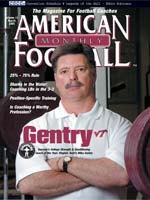AMERICAN FOOTBALL MONTHLY THE #1 RESOURCE FOR FOOTBALL COACHES
|
|
Article Categories
|
The 25% - 75% RuleYear-Round Training With Discipline and Toughness by: Rob Oviatt© More from this issue
The training program I designed
is real simple, and on paper, or in a clinic talk, is probably not
going to turn a lot of heads. Our emphasis instead is on cultivating
attitude and effort, combined with a year-round climate of discipline
and toughness. In summation, 25% of our program is WHAT we do, while
75% is HOW we do it.
Let me first start out by talking about
conditioning. Work capacity, or the ability to sustain effort, is
critical both on the field, and even in the weight room. It is the
foundation for optimizing all physical activity, and the lack of
it, a precursor for injury. As an athlete you d....The full article can only be seen by subscribers.
Subscribe today!

|
|
|
NOT A SUBSCRIBER?
Subscribe
now to start receiving our monthly magazine PLUS get INSTANT
unlimited access to over 4000 pages of 100 percent football coaching
information, ONLY available at AmericanFootballMonthly.com!
|
|
|
HOME
|
MAGAZINE
|
SUBSCRIBE
|
ONLINE COLUMNISTS
|
COACHING VIDEOS
|
Copyright 2026, AmericanFootballMonthly.com
All Rights Reserved
|






